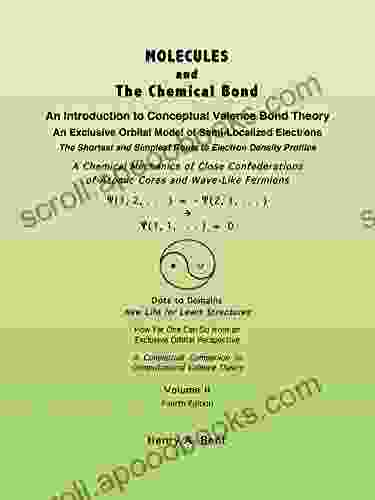: The Building Blocks of Matter
The universe we inhabit is composed of an intricate tapestry of substances, each with its unique properties and characteristics. At the heart of these substances lie molecules, the fundamental building blocks of matter. Molecules, in turn, are formed through the interplay of chemical bonds, the invisible forces that bind atoms together.
The study of molecules and chemical bonds is a captivating branch of science known as molecular chemistry. In this field, scientists seek to comprehend the nature of chemical interactions and uncover the principles that govern the formation and behavior of molecules.
A Journey into the Subatomic Realm
To delve into the realm of molecular chemistry, we must first embark on a microscopic journey into the subatomic world. Atoms, the smallest indivisible units of matter, are composed of even smaller particles: protons, neutrons, and electrons. Protons and neutrons reside in the atom's nucleus, while electrons orbit the nucleus in specific energy levels.
The chemical behavior of an atom is largely determined by its electrons, particularly the outermost electrons known as valence electrons. Valence electrons are responsible for forming chemical bonds with other atoms, creating the diverse array of molecules we encounter in the world around us.
Types of Chemical Bonds: A Spectrum of Interactions
The chemical bond, the force that unites atoms into molecules, manifests in various forms, each with its unique properties and characteristics.
Covalent bonds, the most common type, form when atoms share pairs of valence electrons. These shared electrons occupy molecular orbitals, regions of space where the electrons are most likely to be found. Covalent bonds are typically strong and stable, giving rise to a vast array of organic and inorganic molecules.
Ionic bonds, on the other hand, result from the complete transfer of electrons from one atom to another. The resulting ions, with opposite charges, are electrostatically attracted to each other, forming ionic compounds. Ionic bonds are typically strong and brittle, often found in salts and other crystalline solids.
Hydrogen bonds, a weaker type of intermolecular force, arise from the electrostatic attraction between a hydrogen atom covalently bonded to an electronegative atom (such as oxygen, nitrogen, or fluorine) and another electronegative atom. Hydrogen bonds play crucial roles in biological systems, such as stabilizing protein structures and facilitating molecular recognition.
These are just a few examples of the diverse types of chemical bonds that exist in nature. Each type of bond contributes to the unique properties and characteristics of molecules, influencing their reactivity, solubility, and other physical and chemical properties.
Molecular Structure and Bonding Theories
The arrangement of atoms within a molecule is known as its molecular structure. This structure is determined by the types of chemical bonds formed between the atoms and the number of valence electrons involved.
Chemists employ various bonding theories to predict and explain molecular structures. Valence shell electron pair repulsion (VSEPR) theory, for instance, postulates that electron pairs arrange themselves to minimize electrostatic repulsion, resulting in specific molecular geometries (such as linear, trigonal planar, or tetrahedral).
Molecular orbital theory, a more advanced approach, considers the wave-like behavior of electrons and their distribution within molecular orbitals. This theory provides a deeper understanding of the electronic structure and bonding in molecules.
Applications of Molecular Chemistry: Shaping Our World
The principles of molecular chemistry have far-reaching applications in diverse fields, shaping our world in countless ways.
In the realm of medicine, an understanding of molecular interactions is crucial for developing new drugs and therapies, targeting specific molecules involved in disease processes.
In materials science, molecular chemistry plays a vital role in the design and synthesis of advanced materials with tailored properties, such as lightweight alloys, high-strength polymers, and semiconductors.
In environmental science, molecular chemistry aids in understanding and addressing environmental issues, such as pollution control, remediation of contaminated sites, and the development of sustainable energy sources.
These are but a few examples of the myriad applications of molecular chemistry, a field that continues to drive scientific advancements and shape our technological progress.
: Unlocking the Secrets of the Chemical Bond
The study of molecules and the chemical bond is a captivating journey into the fundamental principles that govern the world around us. Through a deeper understanding of these interactions, we gain insights into the behavior of matter, paving the way for advancements in science, technology, and medicine.
The book "Molecules and the Chemical Bond" serves as an indispensable guide to this fascinating realm, providing a comprehensive exploration of the nature of chemical bonding, molecular structure, and the applications of molecular chemistry. Whether you are a student, researcher, or simply curious about the intricacies of the molecular world, this book will illuminate the pathway to a deeper understanding of the chemical bond.


























































































